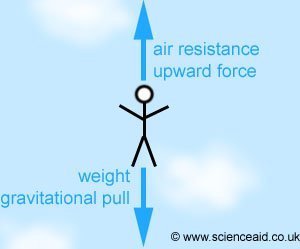Forces in Practice: Terminal Velocity, Spring Extension
Edited by Jamie (ScienceAid Editor), Taylor (ScienceAid Editor)
Terminal velocity
To explain this concept, let's take the example of a sky diver.
- 1To begin with, our sky diver will be accelerating because the weight is greater than the upward force.Advertisement
- 2Until...The upward force - air resistance - increases becoming increasingly closer to the force due to gravity.
The two forces balance and the diver falls at a constant speed called terminal velocity. He will not get any faster.
- 1When the parachute opens, speed will decrease until air resistance and gravitational pull balance, and a new, lower terminal velocity is reached.
So objects reach a terminal velocity because all forces are balanced. And this terminal velocity can only be changed if one of the forces change. The sky diver would get to an even faster terminal velocity if he took off the parachute pack for example.
Science Aid.net does NOT advise sky diving without a parachute!
Elastic and Spring Extension
When a force is applied to a rubber band or spring it changes shape.
- 1The extension is directly proportional to the force (straight line) until a point where more force is required to have equal extension. This point is known as the limit of proportionality or elastic limit. If the force is removed once the spring has reached this point, it will not return to the original shape, and has been deformed.Spring.
- 2The force-extension relationship is not proportional. First less force is required to stretch it, and then more but than the spring, the rubber band will return to its original shape and size.Rubber Band.
Referencing this Article
If you need to reference this article in your work, you can copy-paste the following depending on your required format:
APA (American Psychological Association)
Forces in Practice: Terminal Velocity, Spring Extension. (2017). In ScienceAid. Retrieved Apr 24, 2024, from https://scienceaid.net/physics/forces/inpractice.html
MLA (Modern Language Association) "Forces in Practice: Terminal Velocity, Spring Extension." ScienceAid, scienceaid.net/physics/forces/inpractice.html Accessed 24 Apr 2024.
Chicago / Turabian ScienceAid.net. "Forces in Practice: Terminal Velocity, Spring Extension." Accessed Apr 24, 2024. https://scienceaid.net/physics/forces/inpractice.html.
If you have problems with any of the steps in this article, please ask a question for more help, or post in the comments section below.
Comments
Article Info
Categories : Forces
Recent edits by: Jamie (ScienceAid Editor)







